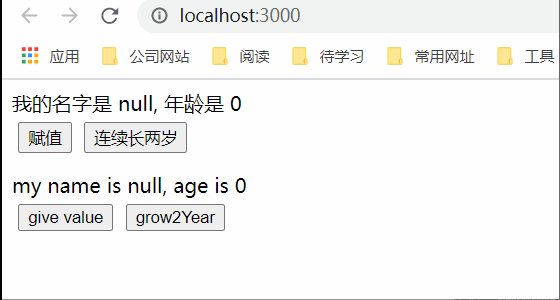组件
组件是React的核心概念,是React应用程序的基石。组件是React开发的一个最小单元,利用“分而治之”的策略,将大的应用分解为很多个小的组件,也方便了组件的复用,更好的践行“高内聚,低耦合”的软件设计原则。
组件有输入、自己的状态和输出,输入在React中叫props,自己的状态在React叫state,输出在React中式render函数返回的值。
总结出的公式(无论props或者state变化,都会触发UI的变化):
UI = render(props,state)
组件的定义(种类)
组件的定义有两种方式,分别是ES6 class(类组件)和使用函数(函数组件)。
类组件
- class继承自React.Component。
- class内部必须定义render方法,render方法返回代表该组件UI的React元素。
示例:
import React from 'react';
import PropeTyps from 'prop-types'
export default class ClassComponent extends React.Component {
render(){
return Hello World!
};
}函数组件
函数组件本质上就是 JavaScript 函数。它接收唯一带有数据的 “props”(代表属性)对象与并返回一个 React 元素。
示例:
function Welcome(props) {
return Hello, {props.name}
;
}有状态组件和无状态组件
state用来反映组件内部状态的变化,如果一个组件的内部状态是不变的,当然就用不到state,这样的组件称为“无状态组件”,反之,用到state的就是有状态组件。无状态组件可以是类组件,也可以是函数组件。
PureComponent
PureComponent是React 15.3引入的一个全新的组件基类,在React内部PureComponent继承自Component,并将isPureComponent属性设置为true。在React内部使用isPureReactComponent来区分是否是PureComponent组件。
PureComponent和Component几乎一样,但是PureComponent的shouldComponentUpdate不会直接返回true,而是会对属性和状态进行浅层比较,也就是仅比较直接属性是否相等。
组件数据
组件的数据分为两种:state和prop
无论是prop或者state的改变,都可能引发组件的重新渲染。prop是组件的对外接口,state是组件的内部状态。
prop: propTypes检查
prop是组件的对外接口,那么就应该有某种方式让组件声明自己的接口规范。
在ES6方法定义的组件类中,可以通过增加类的propTypes属性来定义prop规格,这不只是声明,而且是一种限制,在运行时和静态代码检查时,都可以根据propTypes判断外部世界是否正确地使用了组件的属性。
prop: defaultProps
defaultProps设置props的默认值,有时一个prop不存在,但是需要一个默认值,就可以使用defaultProps。
prop: 实例
TestProps.jsx
import React from 'react';
import PropeTyps from 'prop-types'
export default class TestProps extends React.Component {
render(){
return
姓名: {this.props.name}, 年龄: {this.props.age}
};
}
TestProps.PropeTyps = {
name: PropeTyps.string,
age: PropeTyps.number
}
TestProps.defaultProps = {
name: '张中华'
}index.js
import React from 'react';
import ReactDOM from 'react-dom';
import TestProps from './test-props/TestProps'
ReactDOM.render(
,
document.getElementById('root')
);显示结果
prop: 其他
HTML组件属性的值都是字符串类型,即使内嵌JS,也依然是字符串形式表示代码。React组件的prop所支持的数据类型相对丰富很多,除了字符串还支持其他JS的的数据类型,如:布尔类型,对象等。
除了传值,还可以利用prop传递函数,以达到子组件向父组件传值的目的。
实例(子组件向父组件传值)
TestProps.jsx
import React from 'react';
import PropeTyps from 'prop-types'
export default class TestProps extends React.Component {
getSex = (sex) => {
this.props.getSex(sex);
}
render(){
return
姓名: {this.props.name}, 年龄: {this.props.age}
};
}
TestProps.PropeTyps = {
name: PropeTyps.string,
age: PropeTyps.number
}
TestProps.defaultProps = {
name: '张中华'
}index.js
import React from 'react';
import ReactDOM from 'react-dom';
import TestProps from './test-props/TestProps'
const getSex = (sex) => {
ReactDOM.render(
,
document.getElementById('root')
);
}
ReactDOM.render(
,
document.getElementById('root')
);显示结果
state
由于React组件不能修改传入的prop,所以记录自身的数据就需要使用state。
state:初始化
初始化state只要在组件内,定义this.state对象即可,一般定义在constructor内。
state: 读取
在组件内,使用this.state.XXX直接读取即可
state:更新
state的更新方式是使用this.setState()方法进行更新。如果直接更新state并不会触发界面更新,因为this.setState()方法除了设置state值外,还触发了界面的修改。
this.setState()方法有两种调用方式,一种是直接传入一个对象,另一种是传入一个函数。
源码:
/**
* Sets a subset of the state. Always use this to mutate
* state. You should treat `this.state` as immutable.
*
* There is no guarantee that `this.state` will be immediately updated, so
* accessing `this.state` after calling this method may return the old value.
*
* There is no guarantee that calls to `setState` will run synchronously,
* as they may eventually be batched together. You can provide an optional
* callback that will be executed when the call to setState is actually
* completed.
*
* When a function is provided to setState, it will be called at some point in
* the future (not synchronously). It will be called with the up to date
* component arguments (state, props, context). These values can be different
* from this.* because your function may be called after receiveProps but before
* shouldComponentUpdate, and this new state, props, and context will not yet be
* assigned to this.
*
* @param {object|function} partialState Next partial state or function to
* produce next partial state to be merged with current state.
* @param {?function} callback Called after state is updated.
* @final
* @protected
*/
Component.prototype.setState = function(partialState, callback) {
invariant(
typeof partialState === 'object' ||
typeof partialState === 'function' ||
partialState == null,
'setState(...): takes an object of state variables to update or a ' +
'function which returns an object of state variables.',
);
this.updater.enqueueSetState(this, partialState, callback, 'setState');
};this.setState()方法传入对象与函数的区别在于,传入函数,会根据之前的一个state进行下一次的state的更新,而直接传入对象并不会管前后的state的状态。
state: 实例
TestState.jsx
import React from 'react';
export default class TestState extends React.Component {
constructor () {
super();
this.state = {
name1: 'null',
age1: 0,
name2: 'null',
age2: 0,
}
}
changeStateAsync = () => {
this.setState({ name1: '张' });
this.setState({ age1: 18 });
}
grow2Year1 = ()=> {
this.setState({ age1: this.state.age1 + 1 });
this.setState({ age1: this.state.age1 + 1 });
}
grow2Year2 = ()=> {
this.setState((prevState) => ({
...prevState,
age2: prevState.age2 + 1,
}));
this.setState((prevState) => ({
...prevState,
age2: prevState.age2 + 1,
}));
}
changeStateSync = () => {
this.setState((prevState) => ({
...prevState,
name2: 'Zhang'
}));
this.setState((prevState) => ({
...prevState,
age2: 18
}));
}
render () {
return
我的名字是 {this.state.name1}, 年龄是 {this.state.age1}
my name is {this.state.name2}, age is {this.state.age2}
}
}显示结果
组件样式
内联样式
内联样式实际上是一种CSS in JS的写法:将CSS样式写到JS文件中,用JS对象表示CSS样式,然后通过DOM类型节点的style属性引用相应样式对象。在render中定义,如下:

运行结果

由于是样式是作为一个对象写在JS中的,所以也可以将样式提前声明再引用,如下:
import React from 'react'
export default class TestStyle extends React.Component {
const style1={color:'red'};
render(){returnHello World}
}外部样式
定义在外部css中
新建一个css文件TestStyle.css
.text {color: red;}引用并使用定义好的CSS样式
import React from 'react'
import './TestStyle.css';
export default class TestStyle extends React.Component {
render(){returnHello World}
}运行结果
使用module.css
学习参考:http://www.ruanyifeng.com/blog/2016/06/css_modules.html
新建一个css文件TestStyle.module.css
.text {color: red;}引用并使用定义好的CSS样式
import React from 'react'
import classnames from './TestStyle.module.css'
export default class TestStyle extends React.Component {
render(){returnHello World}
}运行结果
使用方式比较
- 内联样式写在JS中,不利于复用
- 定义在外部css中, CSS的规则都是全局的,容易错乱覆盖
- 使用module.css是局部的,CSS Modules 允许使用:global(.className)的语法,声明一个全局规则。凡是这样声明的class,都不会被编译成哈希字符串。
事件处理
React中的事件是合成事件,并不是原生的DOM事件,React根据W3C规范定义了一套兼容各个浏览器的事件对象。在React中命名事件时,采用驼峰命名方式,而不是原生DOM原生中的小写方式。
在React中使用事件时,最容易混淆的地方就是this的指向问题,这也是JS语言的痛点,虽然后期有了class语法,但是也并不像后端语言那样绑定this到
当前对象。
组件方法(bind)
因为组件内的this并没有绑定到当前对象,所以需要手动去绑定,一般有两种绑定方式,在构造函数中定义或者在元素中直接定义。
在构造函数种定义
import React from "react";
export default class TestEventBind1 extends React.Component {
constructor(props){
super(props);
this.state = {count:0}
this.handleClick = this.handleClick.bind(this);
}
handleClick(){
this.setState({count:this.state.count + 1});
}
render() {
return (
点击次数:{this.state.count}
)
}
}元素中直接定义
import React from "react";
export default class TestEventBind2 extends React.Component {
constructor(props){
super(props);
this.state = {count:0}
}
handleClick(){
this.setState({count:this.state.count + 1});
}
render() {
return (
点击次数:{this.state.count}
)
}
}箭头函数
箭头函数的一个作用就是改变了this的指向问题,在哪定义this就指向谁。这里也有两种方式,一种是在元素内使用,一种是在定义使用。
元素内使用
import React from "react";
export default class TestEventArrowFunction1 extends React.Component {
constructor(props){
super(props);
this.state = {count:0}
}
handleClick(){
this.setState({count:this.state.count + 1});
}
render() {
return (
点击次数:{this.state.count}
)
}
}定义使用
import React from "react";
export default class TestEventArrowFunction2 extends React.Component {
constructor(props){
super(props);
this.state = {count:0}
}
handleClick = () =>{
this.setState({count:this.state.count + 1});
}
render() {
return (
点击次数:{this.state.count}
)
}
}组件方法(bind) VS 箭头函数
bind:在构造函数种定义,如果当存在很多事件时,就会出现很多bind,看起来不好。
bind:元素中直接定义,每次调用render时,都会创建一个新的事件处理函数,带来额外的的性能开销,但是一般情况下不用在意。
箭头函数:元素内使用,每次调用render时,都会创建一个新的事件处理函数,带来额外的的性能开销,但是一般情况下不用在意。
箭头函数: 定义使用,该方法也叫属性初始化语法,该方法时ES7提供的新语法,不用考虑this绑定问题,也不用考虑调用render重新创建处理函数的问题。
综上,根据使用场景,选择合适的定义事件的方法。






